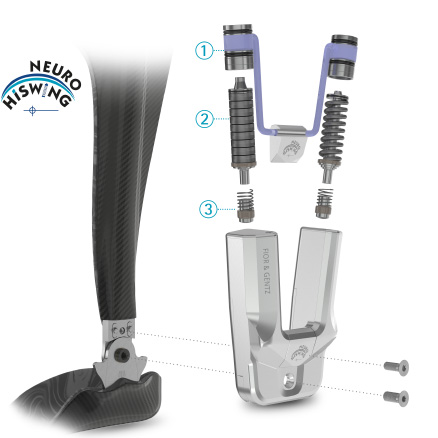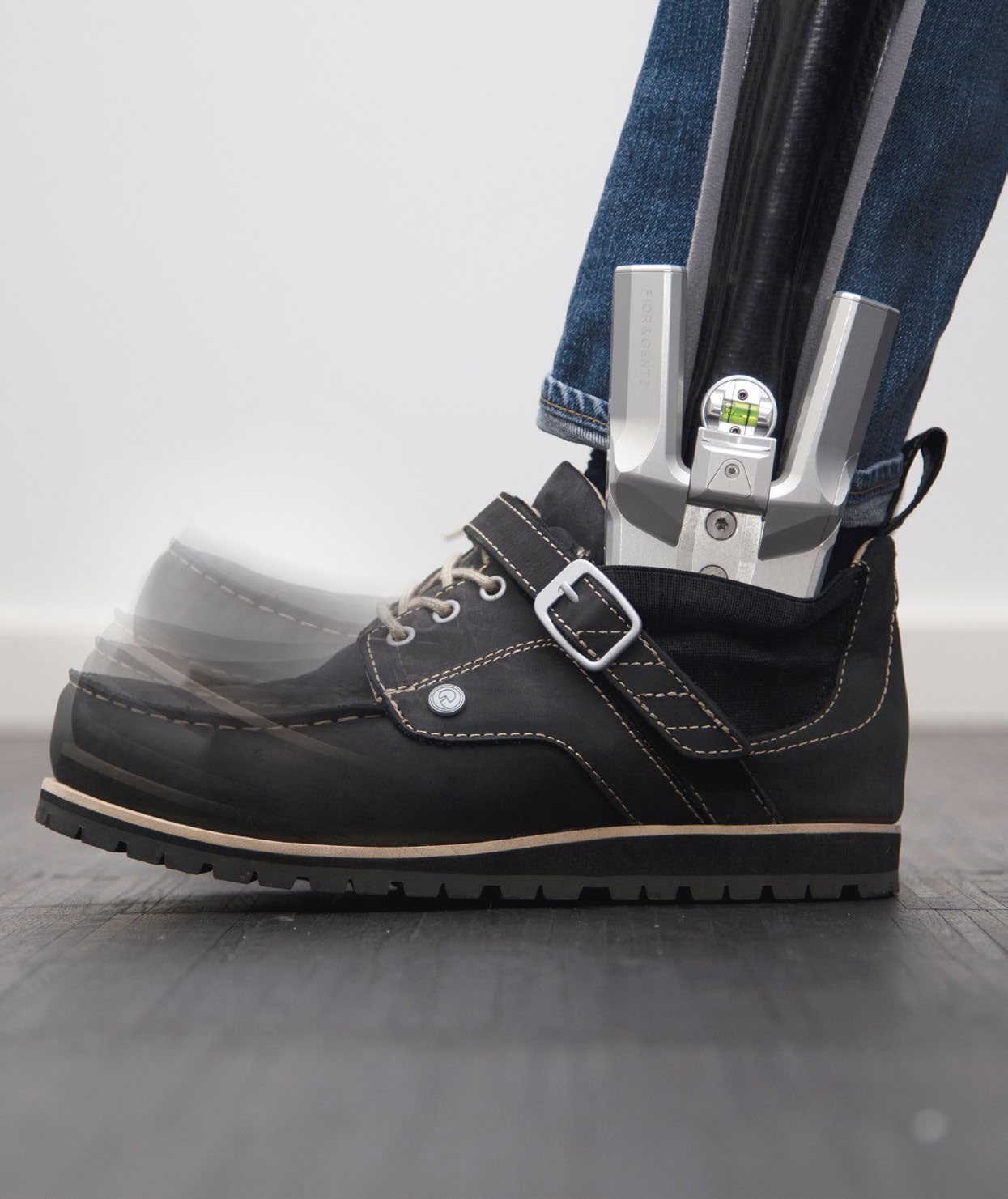The adjustable Neuro Swing system ankle joint from Fior & Gentz is fast becoming a preferred solution to aid the rehabilitation of patients with a neurological condition such as stroke, MS, brain injury and peripheral neuropathy.
The Neuro Swing system enables us to return the patient’s gait pattern to one that is as near normal as possible. By doing this we are also protecting bones and joints and encouraging muscles to work correctly. At LOC we have the advantage of being able to fine-tune the Neuro Swing system in our Gait Lab.
The Neuro Swing AFO has a unilateral ankle joint that is designed to be held within a carbon fibre construction. The joint has two springs, posterior and anterior. The springs can be altered in three ways. Resistance in the springs can be reduced or increased and the range of movement can be altered as can the alignment of the ankle.
The NEURO HiSWING is the latest innovation in AFO technology from Fior & Gentz. It is an exciting development of their Neuro Swing AFO which LOC already prescribes to many patients with neurological conditions. This enhancement means that stairs and even hilly terrains can easily be mastered.
The hydraulic valve allows the wearer to independently change the angle of the ankle joint. This has the following benefits:

image courtesy of Fior & Gentz

image courtesy of Fior & Gentz
For example, if a patient presents with a reduced range of movement and a poor gait pattern due to muscle weakness, we can tune the ankle joint to stretch the affected joint and strengthen the adjoining muscles as well. The joint can be adjusted to change the range of movement over time as the patient improves. If however, a patient presents with some active range of movement, the ability to move their ankle, for example, we want them to use their own muscles to control that movement whereas traditional fixed AFOs would block both good and bad movement.
We work closely with our patient’s physiotherapist and the Neuro Swing system allows tremendous flexibility to respond to an individual’s existing balance, gait and strength, so we can really optimise their walking pattern. Moreover, as the patient progresses and improves during their rehabilitation the springs of the Neuro Swing ankle joint can be continuously adjusted, being adapted and evolving to reflect the patient’s improvement. Our patients love it!
LOC is very grateful to FIOR & GENTZ, Lunenberg, for their permission to use the animated video about the Neuro Swing:
An AFO is an Ankle Foot Orthosis which as the name would suggest encompasses the ankle and foot. The objective is to control the position and movement of the ankle. AFOs are used to support weak limbs; they can also be used to immobilise the ankle and lower leg to correct foot drop. When set up correctly they can also have a great influence on the knee and hip joints. They are the most commonly used Orthoses.
The length of time that one needs to wear an AFO very much depends on the condition being treated. If it is a long-term condition like cerebral palsy or post-polio syndrome it is likely to be years as the condition cannot be cured. Your orthotist will advise you.
A patient’s comfort in their AFO is vital for compliance with the prescribed wearing regime.
So there are a number of steps the orthotist should take to ensure a comfortable fit: the patient’s heel should fit fully into the heel cup without excess space, the contours of the plantar surface of the AFO should match the patient’s foot, for children there needs to be up to half an inch growth room in the toe shelf length. At LOC we use our Gait Laboratories at our Kingston and Manchester clinics to fine-tune our bespoke orthotics.
A GRAFO is used to control instabilities in the lower limb by maintaining proper alignment of limbs and controlling their motion. It reaches around to the front of the knee extending down to the ankle. It works by altering a patient’s limb presentation to displace load and impact as well as offering further control to the knee.
The cost of an AFO is dependent on the type of AFO that has been prescribed and the material that it has been made with. Carbon fibre will be more expensive than metal or plastic for example. LOC’s bespoke AFOs cost can be found on our Orthotic Prices page.
The ability to drive while wearing an AFO is dependent on the condition being treated and the orthosis that has been prescribed. If wearing a hinged AFO, for example, you will be able to drive, but if wearing a knee brace, you won’t. Your orthotist will advise you.
The most flexible type of AFO is a Dynamic Ankle Foot Orthosis (DAFO). It is thin and provides flexible support to the foot and ankle.
Both normal AFOs and DAFOs improve static balance (eg: while standing). Research among MS sufferers suggests that DAFOs aided balance while walking more than AFOs.
The simple answer is: yes they can. However one has to be sensible and look for wide-fitting trousers/jeans preferably of light and thin material.
Typically an AFO is stiff and rigid whereas a DAFO is thin, flexible and wraps around the patient’s entire foot. A DAFO provides support but also allows some range of normal movement.
A Supra Malleolar Orthosis SMO gets its name from the part of the body it encompasses. Thus an SMO supports the leg just above the ankle bone or malleoli. It allows dorsiflexion and plantar flexion(toes up and toes down) but eliminates mediolateral movement.
It typically takes a few weeks but is slightly dependent on the chosen materials and current availability.

“It’s life-changing, my swimming coach has even remarked what a difference my treatment has made" Read how pectus bracing treatment helped to correct Aris' complex chest deformity, involving a combination of pectus excavatum, pectus carinatum and rib flaring.

Cerebral palsy patient Lucas sees significant improvement in his walking after only six months in his new custom Ankle Foot Orthoses (AFOs), designed by Professor Saeed Forghany in our Manchester clinic. Hear how a detailed gait analysis and bespoke AFOs significantly improved Lucas's gait and comfort.

Freddie’s positional plagiocephaly was treated successfully with the LOCBand Lite, going from 11mm to 2mm after four months in his helmet.

Adult club foot (talipes) patient Natasha says, "I cannot stress how amazing my AFOs are and how they have changed so much for me. The support they give me allows me to walk without crutches outside the house for the first time in over fifteen years."

Diagnosed with adolescent idiopathic scoliosis at 14 years old, Polly and mum Zoe looked to the LOC Scoliosis Brace to help her curve and avoid surgery at a later date.

LOC opens its first clinic in Northern Ireland, LOC Belfast, offer non-surgical orthotic treatment for scoliosis, pectus carinatum and pectus excavatum. Here, we will also be able to provide orthotic treatments for a range of adult and paediatric lower limb conditions including cerebral palsy, spina bifida, hypermobility, stroke, post-polio syndrome, and multiple sclerosis.

Mum Natalie shares her experience of having both her identical twins diagnosed with craniosynostosis. Ella and Nina had surgery at Great Ormond Street Hospital before going through cranial remoulding therapy at the London Orthotic Consultancy.

See how a thorough gait analysis and a correctly-fitted, bespoke Reciprocating Gait Orthosis (RGO) helped Ted, a spinal surgery and cancer survivor, improve his rehabilitation and mobility goals, getting him back on his feet again.